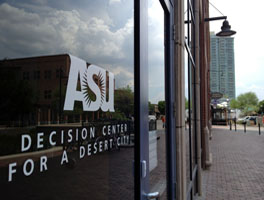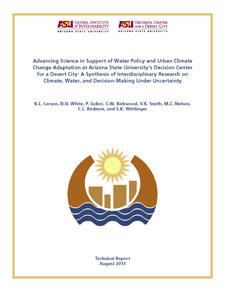 In anticipation of its 10-year anniversary, Arizona State University’s Decision Center for a Desert City (DCDC) has released a major new report, “Advancing Science in Support of Water Policy and Urban Climate Change Adaptation at Arizona State University’s Decision Center for a Desert City: A Synthesis of Interdisciplinary Research on Climate, Water, and Decision-Making Under Uncertainty.” The report summarizes the center’s major achievements in research, education, and community and institutional outreach since its founding in 2004.
In anticipation of its 10-year anniversary, Arizona State University’s Decision Center for a Desert City (DCDC) has released a major new report, “Advancing Science in Support of Water Policy and Urban Climate Change Adaptation at Arizona State University’s Decision Center for a Desert City: A Synthesis of Interdisciplinary Research on Climate, Water, and Decision-Making Under Uncertainty.” The report summarizes the center’s major achievements in research, education, and community and institutional outreach since its founding in 2004.
Funded by the National Science Foundation (NSF) and organized under ASU’s Global Institute of Sustainability, DCDC is focused on water sustainability, urban climate adaptation, and decision-making under uncertainty. The center pursues research, in close collaboration with stakeholders, to create a more sustainable future. Research and modeling efforts analyze interacting factors such as population growth and economic development, climate change and variability, water supplies and demands, and governance to inform water management and other environmental decisions among diverse stakeholders.
 This report was authored by co-investigators Kelli Larson, Dave White, Pat Gober, Craig Kirkwood, V. Kerry Smith, Margaret Nelson, and Charles Redman, along with research professional Sally Wittlinger.
This report was authored by co-investigators Kelli Larson, Dave White, Pat Gober, Craig Kirkwood, V. Kerry Smith, Margaret Nelson, and Charles Redman, along with research professional Sally Wittlinger.
“This synthesis of DCDC findings was essential for us to back up and say, ‘What have we learned from it all, and where are we going next?’” says Kelli Larson, the report’s lead author and a co-principal investigator at DCDC.
Since its founding, DCDC participants have published over 340 peer-reviewed journal articles and book chapters and supported 69 graduate students who have authored 18 doctoral dissertations and 17 master’s theses. In addition, more than 70 undergraduate students have been involved in DCDC’s research through the Internship for Science-Practice Integration, the Community of Undergraduate Scholars program, and other research assistantships.
“The most challenging and complex sustainability problems facing society today—like climate change—require a new approach to science,” says Dave White, DCDC principal investigator and co-director. “We must combine interdisciplinary science within the university with meaningful stakeholder engagement. This ‘transdisciplinary’ approach is reflected in the report, which synthesizes DCDC’s most important findings across a diverse range of disciplines and identifies the most pressing new issues.”
The report recaps the history and role of DCDC within scientific and policy dialogue and then plunges into the research results that have been produced over the years. A major theme is the challenge for cities to provide and maintain secure and reliable water supplies despite an uncertain future that will likely include warming temperatures, reduced precipitation, and more extreme weather events such as droughts, fires, and floods.
“Key findings across DCDC research have revealed uneven spatial and social vulnerabilities to water scarcity and other risks, as well as inevitable tradeoffs and uncertainties in decision-making,” Larson says. “To cope with the complexities of environmental change, collaborations, and social learning across different actors—such as scientists and policy makers, water managers and land use planners—is essential for urban sustainability.”
The report covers topics ranging from climate models used to predict how climate change affects water supplies and demands to analyses on risk perceptions and policy attitudes regarding water resource sustainability. DCDC participants have also contributed substantially to the ASU portfolio of research into climate dynamics including the potential for climate change scenarios to affect regional water resources, in addition to localized urban heat island (UHI) effects and especially their impact on water resources. This work has involved analyzing how urban land-use and land-cover patterns interact with climatic factors to affect water demands.
One of the signature products of DCDC, WaterSim, is described in detail in the report. WaterSim is a systems dynamics model used by researchers, educators, and decision-makers to explore scenarios of climate change, population growth, and how policy choices could alter water supply and demand in central Arizona.
Since its inception, DCDC has served as a type of “boundary organization” designed to bring together academic researchers with diverse stakeholders to ensure that science is not only credible, but also relevant for decision-making. In this role, DCDC has engaged with its partners through educational activities including joint research projects and collaborative workshops. Many of these activities are highlighted throughout the report.

